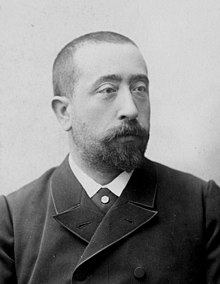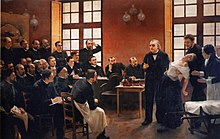Georges Gilles de la Tourette
Georges Gilles de la Tourette | |
|---|---|
 | |
| Born | Georges Albert Édouard Brutus Gilles de la Tourette 30 October 1857 Saint-Gervais-les-Trois-Clochers, Vienne, France |
| Died | 22 May 1904 (aged 46) |
| Known for | Namesake of Tourette syndrome |
Georges Albert Édouard Brutus Gilles de la Tourette (French: [ʒɔʁʒ albɛʁ edwaʁ bʁytys ʒil də la tuʁɛt]; 30 October 1857 – 22 May 1904) was a French neurologist and the namesake of Tourette syndrome, a neurodevelopmental disorder[1][2] characterized by tics.[3] His main contributions in medicine were in the fields of hypnotism and hysteria.[3]
Early life
[edit]Gilles de la Tourette was born the oldest of four children on 30 October 1857[3] in the small town of Saint-Gervais-les-Trois-Clochers in the district of Châtellerault, near the city of Loudun.[4][5]
During 1873, Gilles de la Tourette began medical studies at Poitiers at the age of sixteen.[3] In 1881, he relocated to Paris, where he continued his studies at the Laennec Hospital.[3]
Career
[edit]
Gilles de la Tourette began his internship in 1884, working "at a superhuman pace, publishing, teaching and practicing clinical medicine".[3] He became a student, amanuensis, and house physician of his mentor, influential contemporary neurologist Jean-Martin Charcot, director of the Salpêtrière Hospital.[3][6][7] Charcot also helped him to advance in his academic career. Gilles de la Tourette studied and lectured in psychotherapy, hysteria, and medical and legal ramifications of mesmerism (modern-day hypnosis). Colleagues and historians have described him as a "highly intelligent, if irascible, character".[3]
In 1884, Charcot asked Gilles de la Tourette to work on motor disorders; latah, myriachit, and the Jumping Frenchmen of Maine had recently been described, and Gilles de la Tourette believed the conditions were related and separate from chorea.[3] He described the symptoms of Tourette syndrome in one patient and collected previous observations of similar cases, and in 1885, he published a further nine cases using the name maladie des tics for the disorder.[8] Charcot renamed the syndrome "Gilles de la Tourette's illness" in his honor,[4] although the work was not well received at Salpêtrière.[3]
Gilles de la Tourette published an article on hysteria in the German Army, which angered Bismarck,[9] and a further article about unhygienic conditions in the floating hospitals on the river Thames.[3] With Gabriel Legué, he analyzed 17th-century abbess Jeanne des Anges' account of her hysteria that was allegedly based on her unrequited love for a priest Urbain Grandier, who was later burned for witchcraft.[9]
Personal life and decline
[edit]
Gilles de la Tourette married his cousin Marie Detrois (1867–1922) on 2 August 1887 in Loudon. Paul Brouardel and Charcot were witnesses. They had four children, three of whom lived to adulthood.[10]
In 1893, a former female patient, who was later revealed to have psychosis, shot Gilles de la Tourette in the neck,[3][11][a] claiming one of his colleagues had hypnotized her against her will.[3] His mentor, Charcot, had died recently, and his young son had also died recently.[3] Although he recovered from the shooting and continued to work and organize lectures, after these events, Gilles de la Tourette began to display symptoms of severe depression.[3] After 1893, his mental health noticeably declined.[4]
In 1901, Charcot's son, Jean-Baptiste, convinced Gilles de la Tourette to travel to Switzerland on a ruse, and had him committed to a psychiatric hospital, where Gilles de la Tourette was diagnosed with tertiary syphilis.[12] His condition worsened and he was forced to resign.[4] His wife and colleagues were not forthcoming about the causes of his internment.[13] He died on 22 May 1904[3][4][13] with advanced dementia[4] at the Lausanne Psychiatric Hospital in Cery from what was labeled a status seizure, and that his wife described as apoplexy.[13] Lees (2019) states that "Gilles de la Tourette died of general paralysis of the insane (neurosyphilis)".[9]
Writings
[edit]Gilles de la Tourette published sixteen papers on hysteria, including:[3]
- Les actualités médicales, les états neurasthéniques (Paris 1898)
- Leçons de clinique thérapeutique sur les maladies du système nerveux (Paris 1898)
- L'hypnotisme et les états analogues au point de vue médico-légal (Paris, 1887; 2nd. edition Paris 1889)
- Les actualités médicales. Formes cliniques et traitement des myélites syphilitiques' convulsifs (La semaine médicale 1899)
- Traité clinique et thérapeutique de l'hystérie d'après l'enseignement de la Salpêtrière (Paris 1891)
Notes
[edit]References
[edit]- ^ DSM-5-TR
- ^ ICD-11
- ^ a b c d e f g h i j k l m n o p q Rickards H, Cavanna AE (2009). "Gilles de la Tourette: the man behind the syndrome". J Psychosom Res. 67 (6): 469–74. doi:10.1016/j.jpsychores.2009.07.019. PMID 19913650.
- ^ a b c d e f Teive HA, Chien HF, Munhoz RP, Barbosa ER (December 2008). "Charcot's contribution to the study of Tourette's syndrome". Arq Neuropsiquiatr. 66 (4): 918–21. doi:10.1590/S0004-282X2008000600035. PMID 19099145.
- ^ Walusinski (2019), pp. 3–4.
- ^ Walusinski (2019), pp. xvii–xviii, 23.
- ^ Walusinski (2019), pp. xi, 398. "Interne: House physician or house officer. The internes lived at the hospital and had diagnostic and therapeutic responsibilities. Chef de Clinique: Senior house officer or resident. In 1889, when Gilles de la Tourette was chef de clinique under Charcot ... "
- ^ Dana CL, Wilkin WP (1886). "On convulsive tic with explosive disturbances of speech (So-called Gilles de la Tourette's Disease)". The Journal of Nervous and Mental Disease. 13 (7): 407–412. doi:10.1097/00005053-188607000-00004. S2CID 145727765.
- ^ a b c Lees AJ (April 2019). "Charcot's capricious scribe". Brain. 142 (4): 1161–63. doi:10.1093/brain/awz047.
- ^ Walusinski (2019), pp. 13–16.
- ^ a b Walusinski (2019), p. 72.
- ^ a b Bogousslavsky J, Walusinski O, Veyrunes D (2009). "Crime, hysteria and belle époque hypnotism: the path traced by Jean-Martin Charcot and Georges Gilles de la Tourette". Eur. Neurol. (Historical bio). 62 (4): 193–99. doi:10.1159/000228252. PMID 19602893.
- ^ a b c Walusinski (2019), pp. 113–120.
Books
[edit]- Walusinski O (2019). Georges Gilles de la Tourette: Beyond the Eponym, a Biography. Oxford University Press. ISBN 978-0-19-063603-6
